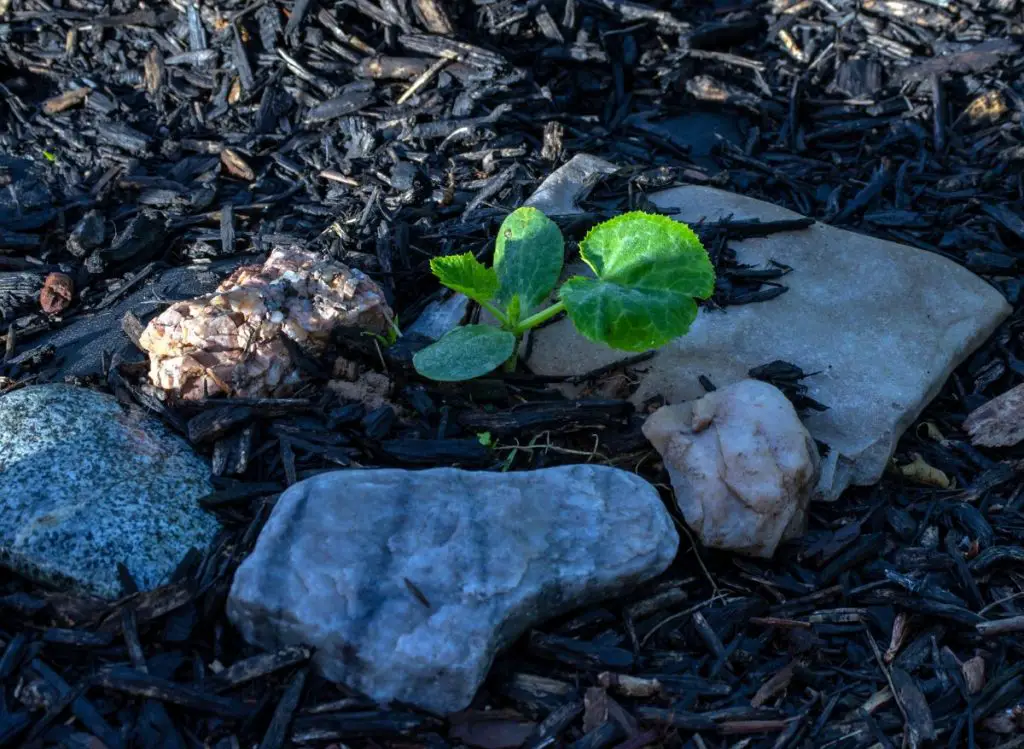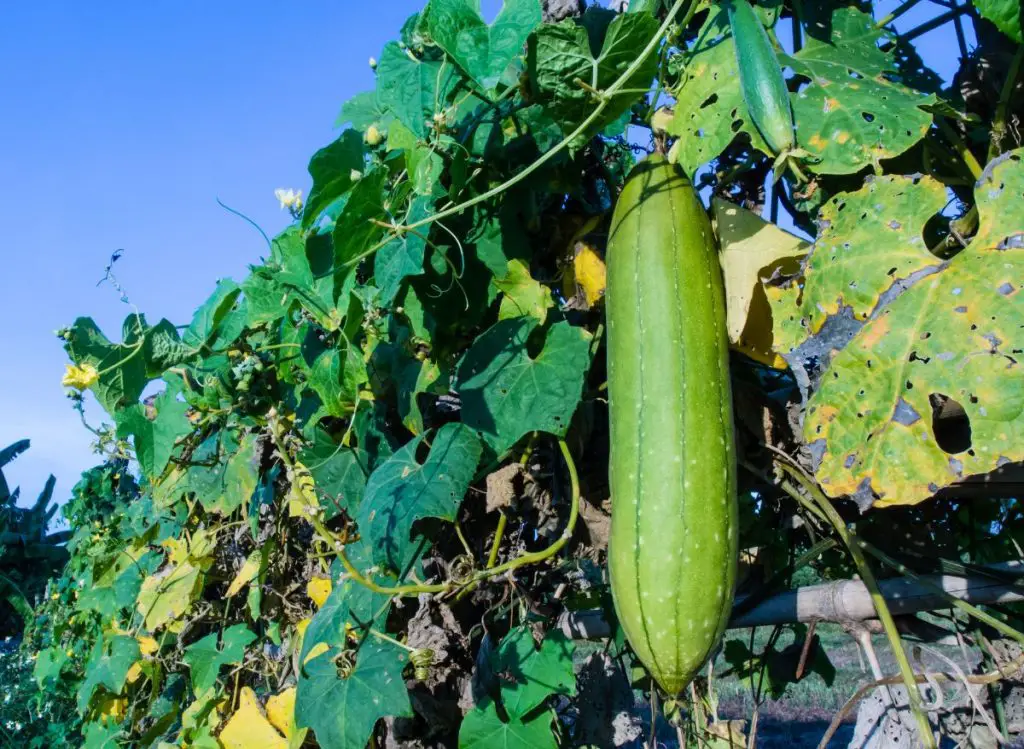
Zucchini is a pretty member of the gourd family. The plants have large, dark green leaves that have ruffled edges, and they produce large yellow flowers that pollinating bees adore. Growing zucchini in your home garden is very easy, and the plants are prolific producers.
Zucchini is a fruit instead of a vegetable because it has and come from seeds, and it grows on the flowering part of the plant. The flowers are edible and are often used to hold some type of stuffing mixture and fried, baked, or steamed.
Use these tips and learn how to plant zucchini plants so you can enjoy the homegrown flavor of this summertime favorite.
Are having issues with your zucchini? Check out this article to find out the reasons why Your Zucchini is Turning Yellow and Rotting.
About Zucchini
Cucurbit, also known as zucchini, scalloped squash, yellow squash, or patty pan squash, is a member of the Cucurbitaceae Family.
Zucchini is native to Italy, France, and Africa, where it has been grown for centuries and is called Marrow. This green squash did not arrive in the United States until the early part of the last century, and it’s been a garden favorite ever since.
The tender squash can be harvested at any stage of development and will remain tender even when the squash has reached a foot or more in length.
Zucchini is versatile and can be eaten raw, baked, fried, steamed, shredded, used in bread recipes, and many other culinary applications. It takes on the flavor of what it’s cooked with and adds bulk to stews and soups.
If you’re looking for a way to stretch food at mealtime while sneaking in some healthy vitamins and minerals, learn how to plant zucchini. It’s naturally low in calories, fat, and sugar, high in fiber, and packed with vitamins, minerals, and antioxidants.
Before Planting Zucchini Plants
Zucchini is a warm-season crop that does not tolerate frost or freezing temperatures. It is recommended to plant zucchini plants in the early summer when temperatures are at least 70 degrees Fahrenheit.
1- Planting Location
Select a planting site that is in full sun most of the day. It would be ideal if you have a location that will receive morning sun and provide a little shade in the afternoon for the plants.
Zucchini grown outdoors in containers will require large containers and frequent watering.
Zucchini can be grown in-ground, in raised beds, or in containers. The plant will reach a mature size of about 3 feet in diameter and 2 feet high so use a raised bed or container that is wide and deep enough to accommodate the plant.
2- Prepare Soil
Prepare the soil before planting seeds by incorporating 2-3 inches of compost into the soil. Do this for both in-ground or raised bed gardens. If planting zucchini in containers, use potting soil that contains compost or add a couple of scoops of compost to each container.
I suggest you select rich and well-drained soil. Generally, zucchini thrives in well-drained, fruitful, loose soil, high in organic matter, with a pH between 5.8 and 6.8 (Source: Cornell University)
Compost is rich in nutrients and will help keep the plants fed. Compost also promotes fast drainage of excess water, prevents soil compaction, allows good airflow around the plant roots, and improves soil structure.
Ensure your zucchini receives sufficient and constant moisture from when the plants sprout until fruits begin filling out.
3- Planting Time
Zucchini is a cool-season vegetable and will only grow when the soil and air are cool. This will work to your advantage and allow you to grow two crops of fresh zucchini each year – one in the spring and a second one in the fall.
For spring planting, wait until all danger of frost has passed and plant the seeds directly outdoors in the ground or containers.
If a late frost or cold snap passes by after the seeds have germinated, cover them with newspaper, plastic jugs, or something else that is lightweight to keep them from freezing. Cover the seedlings the night before and remove the covering before the sun shines on the seedling the following day.
To grow a second crop, plant the seeds in late summer. The zucchini will need about 55 days to go from planting time to harvest time, so count back 55 days from the first predicted frost date of fall and plant seeds close to the date.
How To Plant Zucchini
- Make a planting hole in the prepared soil that is 1/2-inch deep and place 1 zucchini seed in the hole.
- Cover lightly with soil and water well. When planting more than 1 seed, space them out 1 foot apart.
- After the seeds germinate, thin the seedlings out to 2 feet apart.
- Not every seed will germinate, so by planting extra seeds, you help ensure you have all the plants you want.
- The plants will be about 3 feet wide but grow fine if the leaves overlap. The large, overlapping leaves are beneficial to the plants since they grow best in cool weather.
- The leaves help keep the soil cool and shade the soil, so weed seeds can not germinate.
- Zucchini plants are heavy producers, and 1-3 plants will provide plenty of fresh squash for a typical family. You can count on each plant producing between 5-10 pounds of fresh squash.
- If you want to preserve it for the winter or sell some, then 5-10 healthy plants will probably produce more than enough.
- According to Cornell University experts, zucchini seeds can be saved for six years.
Plant Care For Zucchini Plants
- Keep the soil moist for the first month after the seeds are planted. After that,m keep the soil consistently moist. If the plants get too hot or dehydrated, the leaves will wilt. Water immediately if you notice the leaves drooping and wilting.
- Apply water at the soil level in the early morning. Plants can uptake water better in the cool of the early morning hours, so less water will be wasted, and more of the water will be absorbed by the plant.
- Avoid getting the plant foliage wet to help prevent diseases like mildew. Wet foliage also makes the plant more susceptible to pest infestation.
- If the plants seem to be outgrowing their space and the leaves are covering other plants, a few of the oldest leaves can be pruned off. Snip off the oldest, largest leaves near the base of the plant to alleviate overcrowding and promote better air circulation around the plants. All dying leaves can be pruned off as needed.
- Feed the plants immediately after pruning, as pruning will stimulate new growth, and the plant will need an extra boost of nutrition.
- Do not feed the seedlings for the first 4-6 weeks so they can establish a strong root system. Feeding the plants encourages them to develop above-ground growth rather than root growth.
- Once the seedlings have an established root system, feed them with your favorite organic plant food every two weeks. Since the plants are heavy producers, they will also be heavy feeders and drinkers.
- Any organic plant food you use to feed tomatoes and cucumbers will also be great for zucchini. A side dressing of compost will help keep the hungry plants fed.
- Mulch the plants after they are 6 inches tall. Use straw, shredded tree bark, shredded leaves, or other organic material as mulch. The mulch will prevent weed growth, help the soil retain moisture, keep the soil cooler, and will add nutrients to the soil as it slowly decomposes.
If you are looking for good plants to grow with your zucchini, I invite you to read this detailed article: 13 Effective Zucchini Companion Plants To Try Now!

Zucchini Harvest Time
Harvest time depends on the variety of zucchini you are growing. They will be the most tender and have the best flavor when they are 6-8 inches long.
When the plant is no longer producing blooms, it has completed its lifecycle and can be removed from the garden and added to the compost bin.
Tips For Harvesting Zucchini:
- During harvest season, check the plants daily and harvest early in the morning. Zucchini can double in size overnight, so daily inspection of the plants will be needed.
- Cut the squash off the plant with a sharp knife or scissors to harvest. Be gentle so the plant won’t be injured.
- Leave 1-inch of stem attached to the zucchini so it will have a longer shelf life after being harvested.
Zucchini Plants Pests And Diseases
Like any plants, zucchini plants are also susceptible to diseases and pests; here are the most zucchini plants’ pests and diseases.
Zucchini Plants Pests
For more details on Most Common Animals That Eat Zucchini, I invite you to read this article: List Of 11 Animals That Eat Zucchini (And helpful tips to keep them away!)
The table below contains the most common zucchini plants pests and how to get rid of them.
| Zucchini Plants Pests | Solutions |
| Striped Cucumber Beetles | – Build tents of fine netting or cheesecloth, or you can use floating row covers over young plants. – Managing beetles is one of the best ways to prevent bacterial wilt. |
| Squash Bug | – Handpick squash bugs. – Bury or compost plant remains after harvest. |
| Squash Vine Borer | – Try to remove squash vine borers by hand and destroy them. |
Zucchini Plants Diseases
If you live in Oregon, you might be interested in reading: When To Plant Zucchini In Oregon (And everything you must know!)
The table below shows zucchini plants’ common diseases and how to prevent or get rid of them.
| Zucchini Plants Diseases | Solutions |
| Powdery Mildew | – Avoid wetting foliage whenever possible. – Water earlier in the day so aboveground parts will dry as quickly as possible. – To improve air circulation, avoid crowding plants and eliminate weeds around plants and garden areas. |
| Aphids | – Get rid of aphids early in the season by washing them off with water as needed early in the day. – Use a hard stream of water to remove them all at once. |
| Scab | – Keep foliage dry when possible. – Water earlier in the daytime, so aboveground parts will dry quickly. – To improve air circulation, avoid crowding plants and eradicate weeds around plants and garden areas. |
| Downy mildew | – Mix a teaspoon of dormant oil, one tablespoon of baking soda, and one teaspoon of insecticidal or liquid soap (not detergent) into a gallon of water. – Spray on your zucchini plants every one to two weeks. |
Final Thoughts
Zucchini plants are among the easiest plants to add to your garden; they grow fast and are plentiful. They grow about one to two inches daily and can produce about ten pounds of zucchini squash per plant.
Generally, Zucchini plants take approximately two months to harvest, and you can sow and harvest them multiple times per growing season.


